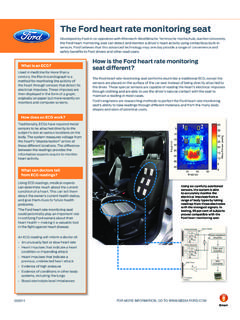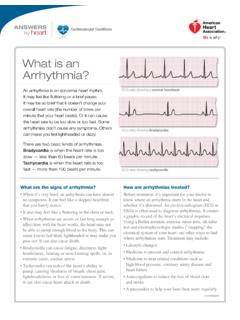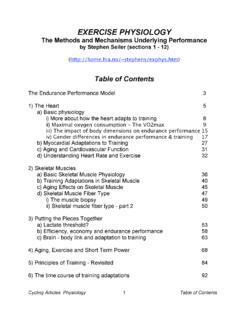Transcription of Heart Rate and Lactate During Endurance Training …
1 Section 4 - Heart Rate and Lactate During Endurance Training programs in Rowing Heart Rate and Lactate During Endurance Training programs in Rowing and its Relation to the Duration of Exercise by Top Elite Rowers Authors: U. Hartmann, A. Mader and W. Hollmann (GER) Secher (29) states that in the course of the last 30 years races in rowing eights have become about 35 seconds faster. Because of the improvement of the performances and the closeness of the results achieved by world class rowers, scientific investigations on rowing have become more and more important.
2 The objectives of these investigations are first the analysis and second the improvement of the physiological performance capacity of rowers (5, 6, 7, 8, 10, 21, 27, 28, 29, 30, 34). Even a superficial look at the Training practice of rowers reveals gaps in the knowledge of the physiological and, more precisely, the metabolic effects of rowing exercises (1, 17). The aim of this study is therefore to analyse and classify the rowing-specific Training loads on the water. During both the preparation and competition periods, several highly qualified (elite) West German rowers underwent Lactate tests at different Training loads on the water.
3 The results of these tests make the determination of the real intensity of the Training exercises possible. Method Between 1985 and 1988, about 40 male rowers (elite) were tested During Training in camps and at home (at sea level). The height of the rowers varied between 194 and 197 cm (6'4" and 6'6"), their average weight was 90 to 95 kg (198-209 lbs.), and their average age was 23 years. They had trained for competition for at least five years. Heart rate was measured by hand immediately after each exercise.
4 In a number of cases, for reasons of comparison, Heart rate was measured both by hand and by telemetry. The maximal individual differences between both methods amounted to four to six beats/minute. Twenty microlitres of capillary blood were taken from the earlobe at the first and third minute after a submaximal exercise and additionally at the fifth, seventh and tenth minutes after a more intensive exercise (see Table 1)(11). The Lactate concentrations were determined enzymatically (20). For every Training exercise (see Table 1) the mean and the standard deviation of both the Lactate concentrations (LA) and the Heart rates (HR) were calculated.
5 Results and Discussion 121 FISA Coaching Development Programme Course - Level III Table l shows the relationship between Lactate and Heart rate During different rowing-specific Training exercises on the water. As expected, the lowest Heart rates were measured During the exercises with the lowest metabolic activities. During extensive Endurance Training exercises (moderate long distance Training - ModLDT), +/- millimol/litre (mmol/l) blood Lactate and + beats/minute Heart rate were measured.
6 During intensive Endurance Training (medium long distance Training - MedLDT), +/- mmol/l blood Lactate and +/- beats/minute were measured. As far as 4 to 7 minute workouts are concerned, Lactate concentrations were found between + mmol/l and +/- mmol/l and Heart rates between + beats/minute and + beats/minute. During tempo Training over different distances (500, 1000, 1500 and 2000m), Lactate levels increased to +/- mmol/l. Heart rate was not measured During competition.
7 However, various authors found a maximal Heart rate of 190 beats/minute after maximal rowing exercises in the laboratory (7, 8, 30, 34). This Heart rate can be considered as a competition value. Table 1: Number, mean, and standard deviation of Lactate [LA (mmol/l)] and Heart rate [HR (min-1)] for different rowing specific intensities. Training Program Number of Sessions (n) Lactate (mmol/l) Heart Rate (per min) Moderate Long Distance (ModLDT) 236 +/- +/- Medium Long Distance (MedLDT) 39 +/- +/- Long Distance Training with 15 strokes 12 +/- +/- Power ( Endurance ) Training (PT) including 80-120 strokes 36 +/- +/- Intensive Long Distance Training (IntLDT; 15-20 min) 16 +/- +/- Intensive Long Distance Training (IntLDT.)
8 10 min) 46 +/- +/- Pyramid ( , 30-40-50-60-50-40-30 strokes) 28 +/- +/- 5 km in Short Time (with Heart rate) 9 +/- +/- 5 km in Short Time (without Heart rate) 20 +/- 10 km in Short Time 25 +/- Alternate Training , 3 x 7 min 32 +/- +/- Alternate Training , 3 x 4 min 26 +/- +/- Alternate Training , 3 x 7 and 3 x 4 min 48 +/- +/- Alternate Training , 2 or 3 x 2 min 10 +/- 2000 m Temp Training , 6 strokes < race frequency 17 +/- +/- 1500 m Tempo Training , 3 strokes ~ race frequency 16 +/- +/- 500m Tempo Training 158 +/- 1000m Tempo Training 83 +/- 1500m Tempo Training 14 +/- Test Regatta - Duisburg 45 +/- International Regatta - Lucerne 38 +/- On the basis of the results mentioned above (see Table 1), we divided the different Training exercises into four categories.
9 122 Section 4 - Heart Rate and Lactate During Endurance Training programs in Rowing category I = more than 8 mmol/l of blood Lactate category II = 4 mmol/l to 8 mmol/l of blood Lactate category III = 2 mmol/l to 4 mmol/l of blood Lactate category IV = Lactate at rest to 2 mmol/l of blood Lactate This division is not arbitrary, but can be justified as follows: If after a submaximal exercise of 10 to 15 minute duration the Lactate concentration is four mmol/l, the Lactate concentration will not increase by more than to mmol/l when continuing this exercise at the same constant speed (intensity) (12, 22).
10 The maximal, but constant intensity for long-term exercises of more than 10 to 15 minute duration can be defined as the maximal Lactate steady state (MaxLass) (13, 19). The mean lactic acid concentration at MaxLass is four mmol/l. All sports medicine specialists consider four mmol/l a reference value (12, 13, 15, 16, 19, 22, 34). In our study on the rowing ergometer, we found Lactate concentrations between two and four mmol/l During long-term exercises (24 to 40 min) (8). However, an Endurance Training session of more than one hour duration at a Lactate concentration close to MaxLass is not possible.









